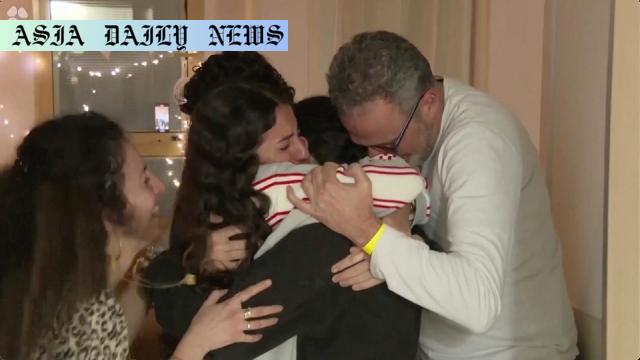Three Israeli women are released as a fragile six-week ceasefire begins between Israel and Hamas, amidst ongoing negotiations.
Three Israeli women hostages were released by Hamas as part of a ceasefire deal.
The six-week ceasefire between Israel and Hamas began after delays.
Talks will continue to aim for a permanent truce and reconstruction.
Israel is set to release Palestinian prisoners during this period.
Massive casualties reported from Gaza during the prolonged conflict.

The conflict between Israel and Hamas took a significant turn on Sunday as three Israeli women were released by the Islamic group, marking the initial steps of a precarious ceasefire agreement. The release comes after weeks of escalating violence and follows extensive negotiations aimed at bringing some measure of peace to the region.
According to the Israeli military, the three hostages were handed over to the International Committee of the Red Cross before being safely transferred to the Israeli side of the border. Reuters reported that the released hostages appeared to be in good health upon their return. Israeli officials have expressed cautious optimism, emphasizing that this move is the first small yet critical gesture in a much larger and delicate arrangement.
This development is part of a broader six-week ceasefire that officially commenced in the Gaza Strip at 11:15 a.m. Sunday, local time. However, the start of the temporary truce was delayed by nearly three hours as final arrangements were ironed out. Hamas, which is believed to be holding approximately 100 hostages, is expected to release 33 hostages in phases over the coming weeks. Local reports suggest that several hostages will be freed in incremental stages as trust builds between the sides.
In a reciprocal move, Israel is set to release an undefined number of Palestinian prisoners as part of the agreement. Moreover, the Israeli military has committed to pulling back from certain densely populated areas within the Gaza Strip. Analysts speculate that these measures are a calculated attempt to reduce hostilities and pave the way for future negotiations.
Gaza’s health authorities, however, remind the world of the staggering humanitarian toll of the conflict. Over 15 months of military offensives have left at least 46,913 people dead in Gaza, a number that has drawn widespread criticism and calls for accountability. The ceasefire has ignited hope among some factions that ongoing negotiations will result in a more permanent resolution to the conflict. In the second and third phases of this agreement, discussions are expected to focus on broader goals, such as reconstruction efforts in Gaza and the establishment of sustainable peace frameworks.
International actors continue to monitor the situation closely, with many urging both sides to uphold their commitments to the ceasefire. However, skepticism persists over whether the agreement’s terms will hold, especially given the deep-seated mistrust between the parties.
For now, the release of the three hostages is a symbolic win for diplomacy amidst decades of entrenched animosity. The coming weeks will undoubtedly prove critical as both sides navigate the fragile path toward de-escalation.



Commentary
Sunday’s release of three Israeli women hostages marks a pivotal moment in the ongoing Israel-Hamas conflict. On the surface, it signifies a glimmer of progress, a rare instance of cooperation between two deeply opposed entities. However, the situation remains fragile, and expectations should be tempered. The six-week ceasefire, while commendable, is only the beginning of what must be a longer journey toward meaningful reconciliation and peace.
The humanitarian toll on Gaza has been overwhelming. With a death toll nearing 50,000 over the past year, the scale of destruction and suffering is difficult to comprehend. Equally harrowing is the plight of hostages—both Israeli individuals taken by Hamas and Palestinian prisoners held in Israeli detention. This mutual exchange, centered around the release of vulnerable individuals, serves as a critical trust-building exercise. However, it would be a mistake to view these initial steps as indicative of a broader resolution. The complexity of the conflict and the deep-seated grievances on both sides cannot be resolved in weeks or even months.
What adds to the uncertainty is the precedent this ceasefire may set. Prolonged negotiations often face setbacks; hardliners on both sides may exploit perceived weaknesses to disrupt progress. For instance, Hamas’ phased release of hostages could be viewed as a strategic move to prolong their leverage, while Israel’s partial military withdrawal may prompt skepticism about its long-term intentions.
Nonetheless, this early exchange plants the seeds for diplomacy to flourish. If handled carefully, the coming weeks could see trust gradually take root, leading to discussions around the reconstruction of Gaza—something desperately needed for the region’s civilian population. The international community must play a pivotal role here, providing aid and ensuring accountability from both parties.
In this context, it is important to maintain a balanced perspective. Optimism should be coupled with a firm acknowledgment of the challenges ahead. Peace, if achieved, will be the result of persistent effort, compromise, and courage on both sides. For now, the release of hostages offers a moment of relief and a sliver of hope. Whether this moment will expand into something more transformative depends entirely on the commitments made during this fragile ceasefire.
As observers of this conflict, we are reminded of the necessity of dialogue amidst the destruction and suffering of war. Every life saved, every community rebuilt, and every moment of peace achieved represents a triumph of human resilience. It is our collective responsibility to push for lasting resolutions, for anything short of that risks perpetuating the cycle of violence.